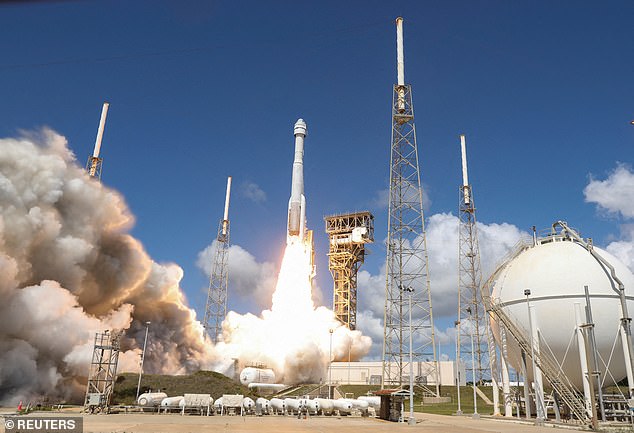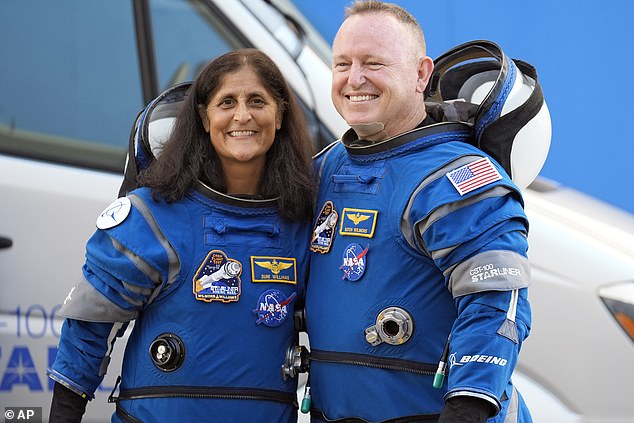NASA said it needs at least another week to determine how long its stranded astronauts will be in space because of Boeing’s faulty spacecraft.
In a crucial update, space agency officials repeated last week’s line that one of the most likely options is to attach them to a different mission that would bring them home in February 2025.
NASA astronauts Sunita Williams and Barry Wilmore were only supposed to be there for eight days when they blasted off on Boeing’s Starliner in June, but a problem with the craft’s propulsion system means it’s not safe to undock them and bring them back home.
POT Officials said one of their biggest concerns is that Starliner would burn up in Earth’s atmosphere when it attempts reentry, which would incinerate anyone on board.
The fate of stranded astronauts Sunita Williams (left) and Barry Wilmore (right) remains unclear as NASA and Boeing work on a plan to bring them home.
“That’s why we’re looking so closely at the thrusters and even thinking about how the larger thrusters work,” they said during a news conference Wednesday.
The plan for February 2025 involves attaching astronauts to a mission involving Elon Musk’s Space X Dragon craft.
It is scheduled to launch in September and return them to Earth with that mission next February.
If they go the SpaceX route, there will be additional health risks for astronauts.
Each additional day astronauts spend in space exposes them to more radiation, which could cause them to develop cancer later in life.
The International Space Station has shielding that reduces the amount of space radiation astronauts are exposed to, but they still endure about 365 times more radiation than we do here on Earth.
Additionally, the spacesuits Williams and Wilmore wore on their way to the ISS would not be suitable for Crew Dragon, meaning the astronauts would have to make the return trip home without a suit, officials said.
Without the protection that spacesuits provide, Williams and Wilmore could face additional dangers during the return flight.
But there are also risks associated with returning on Boeing’s Starliner, which faced numerous technical problems before, during and after its launch to the ISS in June.

NASA says there’s a chance Boeing’s faulty Starliner could still return Williams and Wilmore to Earth, despite numerous technical problems with the spacecraft.
Williams and Wilmore had hoped to return to Earth in about a week, but thruster failures and helium leaks on the Starliner prompted NASA and Boeing to keep the two astronauts in orbit longer out of fear that a return trip on the spacecraft could end in disaster.
Despite these problems, Boeing remains hopeful that its spacecraft can return to Earth with Wilmore and Williams on board.
“We continue to believe in Starliner’s capabilities and flight logic. If NASA decides to change the mission, we will take the necessary steps to configure Starliner for an uncrewed return,” a Boeing spokesperson previously told DailyMail.com in an emailed statement.
NASA also remains confident in Starliner’s capabilities.
Officials said the fact that astronauts can spend weeks aboard the International Space Station means they have time to try to resolve technical problems with the spacecraft.
“We’ve had very honest conversations with each other and I’m not surprised that the Boeing team is 100 percent behind their vehicle,” said Ken Bowersox, associate administrator for NASA’s Space Operations Mission Directorate.
“But I can also tell you that they want to work with us in a partnership. Whatever the NASA team thinks is important, and when we come to a decision, we’ll work on it together,” he added.
But one expert told the BBC that some NASA decision-makers probably remain unconvinced.
Officials previously stated that they would make a decision on the return plan by mid-August, but have now postponed the decision deadline until the last week of the month.
But there is no precise limit.
NASA’s chief astronaut, Joe Acaba, said astronauts like Williams and Wilmore “embark on missions fully aware of the various scenarios and outcomes that can become our realities.”
“This mission was a test flight… they knew this mission might not be perfect,” he said.
At the moment, it appears that Williams and Wilmore are “doing fine.”
“In my office right now I can see them working on the ISS,” Abaca said, adding that they have fully integrated into the station’s crew.
“But we are human,” he said. “And this is hard on the crew members and their families, and we take that into account.”

